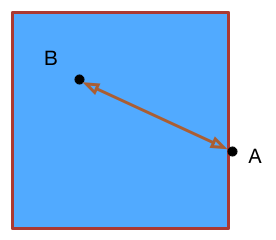Similar to AMC 10A #25
 Let
S
be a square of side length
1
. Two points
A
and
B
are chosen independantly at random such that
A
is on the perimeter while
B
is strictly inside the square. The probability that the straight-line distance between
A
and
B
is at least
2
1
is
c
a
−
b
π
, where
a
,
b
, and
c
are positive integers and
g
cd
(
a
,
b
,
c
)
=
1
. What is
a
+
b
+
c
?
Let
S
be a square of side length
1
. Two points
A
and
B
are chosen independantly at random such that
A
is on the perimeter while
B
is strictly inside the square. The probability that the straight-line distance between
A
and
B
is at least
2
1
is
c
a
−
b
π
, where
a
,
b
, and
c
are positive integers and
g
cd
(
a
,
b
,
c
)
=
1
. What is
a
+
b
+
c
?
The answer is 53.
This section requires Javascript.
You are seeing this because something didn't load right. We suggest you, (a) try
refreshing the page, (b) enabling javascript if it is disabled on your browser and,
finally, (c)
loading the
non-javascript version of this page
. We're sorry about the hassle.
2 solutions
[This is not a full solution.]
We find that the probability is determined by the integral 2 ∫ 0 2 1 2 x 4 1 − x 2 + 8 π − cos − 1 2 x d x = 2 4 2 6 − 3 π so the answer is 2 6 + 2 4 + 3 = 5 3
We did the EXACT same thing! We first found the probability when x is a randomly chosen point on a side, and found the average value of the probability over the interval [0,0.5]*2 by symmetry.
I assumed that I can just treat the point on the perimeter as if it's chosen at random along half of 1 side (from a corner to a midpoint) because no matter where the random point on the perimeter is chosen, the square can be reoriented so that it lies on the same line segment (from a corner to the midpoint of a side).
Call the distance from the corner y. From the above assumption, y ranges from [0, 0.5] Take a look at my drawing of the situation:
0 . 5 d y = 2 d y would be the chance of the random point being (within dy of) y
So the chance that the distance is less than 0.5 should be 0 ∫ 0 . 5 2 A ( y ) d y
So now we just need to find find A(y) which is:
A ( y ) = 0 ∫ y + 0 . 5 0 . 2 5 − ( y − x ) 2 d x
This gives 1 2 3 p i − 2
Initially, I misread the problem, so I calculated the chance that the distance is at most 0.5.... So just take 1 minus my answer to get the correct answer :)